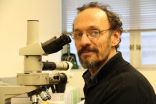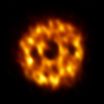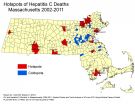INFORMATION:
The work was supported by the National Science Foundation, National Institutes of Health, Defense Threat Reduction Agency, Office of Naval Research and the National Research Council.
Writer
Emil Venere
765-494-4709
venere@purdue.edu
Source
Gary J. Cheng
765-494-5436
gjcheng@purdue.edu
Minghao Qi
765-494-3646
mqi@purdue.edu
Abstract
Large Scale Nanoshaping of Ultrasmooth 3D Crystalline Metallic Structures
Huang Gao1, Yaowu Hu1, Yi Xuan, Ji Li1, Yingling Yang1, Ramses V. Martinez, Chunyu Li, Jian Luo, Minghao Qi, Gary J. Cheng
Gary J. Cheng is the corresponding author. E-mail: gjcheng@purdue.edu
This paper reports a low-cost, high-throughput, benchtop method that enables thin layers of metal to be shaped with nanoscale precision by generating ultrahigh-strain-rate deformations. Laser shock imprinting can create 3D crystalline metallic structures as small as 10 nm with ultrasmooth surfaces at ambient conditions. This technique enables the successful fabrications of large-area, uniform nanopatterns with aspect ratios as high as 5 for plasmonic and sensing applications, as well as mechanically strengthened nanostructures and metal-graphene hybrid nanodevices.
Nanoshaping method points to future manufacturing technology
2014-12-11
(Press-News.org) WEST LAFAYETTE, Ind. - A new method that creates large-area patterns of three-dimensional nanoshapes from metal sheets represents a potential manufacturing system to inexpensively mass produce innovations such as "plasmonic metamaterials" for advanced technologies.
The metamaterials have engineered surfaces that contain features, patterns or elements on the scale of nanometers that enable unprecedented control of light and could bring innovations such as high-speed electronics, advanced sensors and solar cells.
The new method, called laser shock imprinting, creates shapes out of the crystalline forms of metals, potentially giving them ideal mechanical and optical properties using a bench-top system capable of mass producing the shapes inexpensively
Findings are detailed in a research paper appearing Friday (Dec. 12) in the journal Science. The paper is authored by researchers from Purdue University, Harvard University, Madrid Institute for Advanced Studies, and the University of California, San Diego. The research is led by Gary Cheng, an associate professor of industrial engineering at Purdue.
The shapes, which include nanopyramids, gears, bars, grooves and a fishnet pattern, are too small to be seen without specialized imaging instruments and are thousands of times thinner than the width of a human hair. The researchers used their technique to stamp nanoshapes out of titanium, aluminum, copper, gold and silver.
A key benefit of the shock-induced forming is sharply defined corners and vertical features, or high-fidelity structures.
"These nanoshapes also have extremely smooth surfaces, which is potentially very advantageous for commercial applications," Cheng said. "Traditionally it has been really difficult to deform a crystalline material into a nanomold much smaller than the grain size of starting materials, and due to the size effects the materials are super-strong when grain size has to be reduced to very small sizes. Therefore, it is very challenging to generate metal flow into nanomolds with high-fidelity 3-D shaping."
The researchers also created hybrid structures that combine metal with graphene, an ultrathin sheet of carbon promising for various technologies. Such a hybrid material could enhance the plasmonic effect and bring "metamaterial perfect absorbers," or MPAs, which have potential applications in optoelectronics and wireless communications.
"We can generate nanopatterns on metal-graphene hybrid materials, which opens new ways to pattern 2-D crystals," Cheng said.
The technique works by using a pulsed laser to generate "high strain rate" imprinting of metals into the nanomold.
"We start with a metal thin film, and we can deform it into 3-D nanoshapes patterned over large areas," Cheng said. "What is more interesting is that the resulting 3-D nanostructures are still crystalline after the imprinting process, which provides good electromagnetic and optical properties."
Whereas other researchers have created nanoshapes out of relatively soft or amorphous materials, the new research shows how to create nanoshapes out of hard and crystalline metals.
The silicon nanomolds were fabricated at the Birck Nanotechnology Center in Purdue's Discovery Park by a research group led by Minghao Qi, an associate professor of electrical and computer engineering.
"It is counter-intuitive to use silicon for molds because it is a pretty brittle material compared to metals," Qi said. "However, after we deposit an ultrathin layer of aluminum oxide on the nanomolds, it performs extremely well for this purpose. The nanomolds could be reused many times without obvious damage. Part of the reason is that although the strain rate is very high, the shock pressure applied is only about 1-2 gigapascals."
The shapes were shown to have an "aspect ratio" as high as 5, meaning the height is five times greater than the width, an important feature for the performance of plasmonic metamaterials.
"It is a very challenging task from a fabrication point of view to create ultra-smooth, high-fidelity nanostructures," Qi says. "Normally when metals recrystallize they form grains and that makes them more or less rough. Previous trials to form metal nanostructures have had to resort to very high pressure imprinting of crystalline metals or imprinting amorphous metal, which either yeilds high roughness in crystalline metals or smooth surfaces in amorphous metals but very high electrical resistance. For potential applications in nanoelectronics, optoelectronics and plasmonics you want properties such as high precision, low electromagnetic loss, high electrical and thermal conductivity. You also want it to be very high fidelity in terms of the pattern, sharp corners, vertical sidewalls, and those are very difficult to obtain. Before Gary's breakthrough, I thought it unlikely to achieve all of the good qualities together."
The paper was authored by Purdue doctoral students Huang Gao, Yaowu Hu, Ji Li, and Yingling Yang; researcher Ramses V. Martinez from Harvard and Madrid Institute for Advanced Studies; Purdue research assistant professor Yi Xuan, Purdue research associate Chunyu Li; Jian Luo, a professor at the University of California, San Diego; Qi and Cheng.
Future research may focus on using the technique to create a roll-to-roll manufacturing system, which is used in many industries including paper and sheet-metal production and may be important for new applications such as flexible electronics and solar cells.
ELSE PRESS RELEASES FROM THIS DATE:
Obese children's brains more responsive to sugar
2014-12-11
A new study led by researchers at University of California, San Diego School of Medicine finds that the brains of obese children literally light up differently when tasting sugar.
Published online in International Journal of Obesity, the study does not show a causal relationship between sugar hypersensitivity and overeating but it does support the idea that the growing number of America's obese youth may have a heightened psychological reward response to food.
This elevated sense of "food reward" - which involves being motivated by food and deriving a good feeling ...
Scientists reveal new family tree for birds, clear back to dinosaur parents
2014-12-11
PORTLAND, Ore. -- A large international group of scientists, including an Oregon Health & Science University neuroscientist, is publishing this week the results of a first-ever look at the genome of dozens of common birds. The scientists' research tells the story of how modern birds evolved after the mass extinction that wiped out dinosaurs and almost everything else on Earth 66 million years ago, and gives new details on how birds came to have feathers, flight and song.
The consortium of more than 200 scientists is publishing its findings nearly simultaneously this week ...
Stacking 2-dimensional materials may lower cost of semiconductor devices
2014-12-11
A team of researchers led by North Carolina State University has found that stacking materials that are only one atom thick can create semiconductor junctions that transfer charge efficiently, regardless of whether the crystalline structure of the materials is mismatched - lowering the manufacturing cost for a wide variety of semiconductor devices such as solar cells, lasers and LEDs.
"This work demonstrates that by stacking multiple two-dimensional (2-D) materials in random ways we can create semiconductor junctions that are as functional as those with perfect alignment" ...
New insights into the origins of agriculture could help shape the future of food
2014-12-11
Agricultural decisions made by our ancestors more than 10,000 years ago could hold the key to food security in the future, according to new research by the University of Sheffield.
Scientists, looking at why the first arable farmers chose to domesticate some cereal crops and not others, studied those that originated in the Fertile Crescent, an arc of land in western Asia from the Mediterranean Sea to the Persian Gulf.
They grew wild versions of what are now staple foods like wheat and barley along with other grasses from the region to identify the traits that make some ...
Decoding the Tree of Life
2014-12-11
GAINESVILLE, Fla. --- Nature abhors a vacuum, which may explain the findings of a new study showing that bird evolution exploded 65 million years ago when nearly everything else on earth -- dinosaurs included -- died out.
The study is part of an ambitious project, published in today's issue of the journal Science, in which hundreds of scientists worldwide have decoded the avian genome.
Edward Braun, an evolutionary geneticist at the University of Florida and the UF Genetics Institute, is one of the key scientists who took part in this multi-year project that used nine ...
Home on the range
2014-12-11
(Santa Barbara, Calif.) -- With more and more rainforest giving way to pasture and grazing land every year, the practice of cattle ranching in the Amazon has serious implications on a global scale. At the same time, however, it provides a degree of socioeconomic flexibility for Amazonian smallholders who simply can't survive on what the forest or agriculture provide.
In a paper published in the current issue of the journal Human Organization, UC Santa Barbara anthropologist Jeffrey Hoelle takes a look at the rise of cattle ranching in the Brazilian state of Acre and the ...
Swarms of Pluto-size objects kick-up dust around adolescent Sun-like star
2014-12-11
Astronomers using the Atacama Large Millimeter/submillimeter Array (ALMA) may have detected the dusty hallmarks of an entire family of Pluto-size objects swarming around an adolescent version of our own Sun.
By making detailed observations of the protoplanetary disk surrounding the star known as HD 107146, the astronomers detected an unexpected increase in the concentration of millimeter-size dust grains in the disk's outer reaches. This surprising increase, which begins remarkably far -- about 13 billion kilometers -- from the host star, may be the result of Pluto-size ...
Weighing in on the role of mindfulness in slimming down
2014-12-11
COLUMBUS, Ohio - If dieting is on your New Year agenda, it might pay to be mindful of a study suggesting there is little hard evidence that mindfulness leads to weight loss.
Ohio State University researchers reviewed 19 previous studies on the effectiveness of mindfulness-based programs for weight loss. Thirteen of the studies documented weight loss among participants who practiced mindfulness, but all lacked either a measure of the change in mindfulness or a statistical analysis of the relationship between being mindful and dropping pounds. In many cases, the studies ...
Geospatial study identifies hotspots in deaths from HIV/AIDS and Hepatitis C in Massachusetts
2014-12-11
BOSTON (December 11, 2014) -- A new study from epidemiologists at Tufts University School of Medicine helps to identify communities with the greatest public health need in Massachusetts for resources relating to HIV/AIDS and hepatitis C. The study, published today in PLOS ONE, used geospatial techniques to identify hotspots for deaths related to HIV/AIDS and hepatitis C. The findings show large disparities in death rates exist across race and ethnicity in Massachusetts.
The HIV/AIDS and hepatitis C epidemics are challenging public health officials and clinicians in the ...
New discoveries in age-related macular degeneration revealed in industry and academia
2014-12-11
BALTIMORE, December 11, 2014 - Insilico Medicine along with scientists from Vision Genomics and Howard University shed light on AMD disease, introducing the opportunity for eventual diagnostic and treatment options.
The scientific collaboration between Vision Genomics, Inc., Howard University, and Insilico Medicine, Inc., has revealed encouraging insight on the AMD disease using an interactome analysis approach. Resources such as publicly available gene expression data, Insilico Medicine's original algorithm OncoFinderTM, and AMD MedicineTM from Vision Genomics allowed ...



